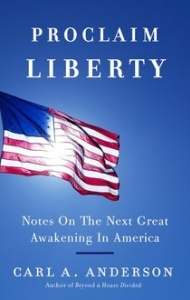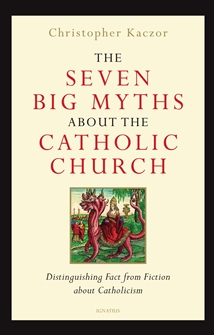The Seven Big Myths About the Catholic Church: Distinguishing Fact from Fiction about Catholicism
Dr. Christopher Kaczor
Over the last few years, I’ve had many discussions with Protestants, Mormons, atheists, and agnostics. If there’s one thing they all share in common, it’s a profound confusion about what the Catholic Church actually teaches. Venerable Fulton Sheen was right: “There are not more than 100 people in the world who truly hate the Catholic Church, but there are millions who hate what they perceive to be the Catholic Church.”
 Dr. Christopher Kaczor agrees, and in his new book The Seven Big Myths About the Catholic Church: Distinguishing Fact from Fiction about Catholicism (Ignatius Press, hardcover, 164 pages) he clears up seven of the biggest misunderstandings. The chosen myths include:
Dr. Christopher Kaczor agrees, and in his new book The Seven Big Myths About the Catholic Church: Distinguishing Fact from Fiction about Catholicism (Ignatius Press, hardcover, 164 pages) he clears up seven of the biggest misunderstandings. The chosen myths include:
- The Church opposes science
- The Church opposes freedom and happiness
- The Church hates women
- The Church is indifferent to love because she rejects contraception
- The Church hates gays
- The Church opposes same-sex marriage for irrational reasons
- The Church’s abuse crisis was due to priestly celibacy
In each chapter, Kaczor untwists the objection by combining Church teaching with historical, psychological, and social data. For example, when proving that the Church supports science, he provides several excerpts from papal teachings that hold reason and research in high regard. Even more, he highlights many great scientists who were either Catholic or educated in Catholic institutions. Finally, he explains how the Catholic Church is one of the biggest proponents of science today through her astronomy labs, research funding, and universities. He deals with controversial subjects, like the Galileo case, but shows how these outliers fit into a much larger, pro-science narrative.
Besides the chapter on science, Kaczor’s chapters on contraception and homosexuality are especially sharp. I agree with Dr. Peter Kreeft who says, “The chapter on contraception is the most simple, commonsensical, winsome, and persuasive I have ever seen…The chapter on same-sex marriage has the clearest and the completest logic I have ever read on the subject.” If you’re looking for straightforward, rational explanations for why the Church opposes both contraception and same-sex marriage, these will help.
My only critique surrounds the second chapter, which deals with the myth that says Catholicism opposes freedom and happiness. The chapter stuck out to me both for its length and its topic. The chapter is twice as long as some of the others, and it addresses an objection which, in my experience, is uncommon among non-Catholics. Like all the others, the chapter is convincing and well-written but I wonder whether another “myth” could have been substituted, perhaps “Catholicism is built on pagan mythology.”
In a religiously illiterate world, evangelization is about clarification as much as proclamation. That makes Dr. Kaczor’s Seven Big Myths About Catholicism a real winner. It’s a valuable tool for the New Evangelization and will help clear away the biggest roadblocks people have to the Catholic Church.
Catholicism Pure and Simple
Fr. Dwight Longenecker
People love C.S. Lewis for many reasons, but perhaps none more than his remarkable clarity. Despite being an Oxford Don and a world-class literary scholar, Lewis’ writings were unpretentious. He wrote about heavy topics like theology, evil, heaven, hell, suffering, and prayer, yet refused to use long words and abstract theories. He rejected the idea that one must be complex to be profound.
 Fr. Dwight Longenecker, who studied at Lewis’ alma mater, is cut from the same mold. He’s a talented writer and thinker, but his main gift is bringing lofty spiritual concepts down to earth. In his newest book, Catholicism Pure and Simple (Stauffer Books, paperback, 264 pages), he applies this gift to a wide overview of the Catholic faith.
Fr. Dwight Longenecker, who studied at Lewis’ alma mater, is cut from the same mold. He’s a talented writer and thinker, but his main gift is bringing lofty spiritual concepts down to earth. In his newest book, Catholicism Pure and Simple (Stauffer Books, paperback, 264 pages), he applies this gift to a wide overview of the Catholic faith.
Taking readers on a journey all the way from the existence of God to the realities of heaven and hell, he avoids complicated theology, hi-brow references, and confusing arguments. He uses simple language to explain the basics to skeptics, doubters, and fledglings alike. Yet like Lewis, Fr. Longenecker remains simple without being simplistic.
Each chapter is also broken down into small blog-post sized chunks. That makes it perfect for light devotional reading, or the kind of fun book you can pick up on a whim and read for a few minutes.
If you’re looking for something to give to your teenager, college-student, RCIA candidate, or Catholic friend who wants to learn more about her faith, I highly recommend Catholicism Pure and Simple.
Proclaim Liberty: Notes on the Next Great Awakening in America
Carl Anderson
Within the past year, Image Books has released two short eBooks on faith and public life, one by Cardinal Timothy Dolan and the other by Archbishop Charles Chaput. Now they’re back with a third, this one titled, Proclaim Liberty: Notes on the Next Great Awakening in America (Image, ebook, 35 pages). The book includes three essays by Knights of Columbus President Carl Anderson on how Catholics can live out our faith publicly, transforming our divisive political atmosphere into a “civilization of love.”
 Anderson begins his first essay by reflecting on the many threats to religious liberty. Citing Pope Benedict XVI and St. Thomas More, he calls Catholics to persevere in our commitment to Catholic identity and to not let up the fight for this first, most cherished freedom.
Anderson begins his first essay by reflecting on the many threats to religious liberty. Citing Pope Benedict XVI and St. Thomas More, he calls Catholics to persevere in our commitment to Catholic identity and to not let up the fight for this first, most cherished freedom.
In the second essay, he offers solutions for the gridlock and vitriol that plague modern politics. He urges Catholics to transcend mere partisanship and move into a “new political coalition” grounded in Catholic social teaching.
Finally, in his third essay, Anderson focuses on immigration and its connection to the New Evangelization. In discussing the role of Our Lady of Guadalupe in the mass conversion of Latin America, he notes that the Mexican people still play a primary role today in evangelizing the rest the Western hemisphere today. It’s because of Latin immigrants that the Church in America has grown from one of the smallest Christian populations to the largest. For this and other reasons, immigrants deserve to be treated with compassion and dignity, not hatred and rejection. Following the immigration guidelines of the USCCB, Anderson proposes a fair and reasonable response to the problem, one that is at both prudent and respectful.
In just 35 pages, Proclaim Liberty covers a wide-range of political and religious issues. It’s almost like three smaller books in one, and not quite as pointed as Cardinal Dolan’s or Archbishop Chaput’s.
However, by the end, Anderson makes a strong case that our politics need an infusion of charity, and that if the “civilization of love” will ever arrive, Catholics must herald it in.
What Must I Do to be Saved?
Marcus Grodi
In St. Luke’s Gospel, we find a young man approaching Christ with a very important question: What must I do to be saved? If the the mark of true intelligence is asking the right questions, this man was smart. His is the most important question anyone can ask: What must I do to save my soul?
 Depending which Christian group you ask today, you’ll get plenty of conflicting answers. Many sincere Protestants will say “all you need is a personal relationship with Jesus Christ.” Others say “the only requirement is heart-felt faith.” Still others maintain that you must pray a sinner’s prayer. But which one is right? And what about the sacraments, like baptism? What about the Church? Are they necessary for salvation, too?
Depending which Christian group you ask today, you’ll get plenty of conflicting answers. Many sincere Protestants will say “all you need is a personal relationship with Jesus Christ.” Others say “the only requirement is heart-felt faith.” Still others maintain that you must pray a sinner’s prayer. But which one is right? And what about the sacraments, like baptism? What about the Church? Are they necessary for salvation, too?
In his slim new book, What Must I do to be Saved? (CHResources, paperback, 91 pages), Catholic-convert and EWTN host Marcus Grodi provides a clear and accessible answer to each of those questions.
He begins by examining many popular approaches, including the fundamentalist “Me and Jesus alone” style and the popular “Roman Road” presentation. With characteristic charity, Grodi points out that each of these approaches is partially true, but nevertheless deeply flawed.
He walks readers through the Old Testament, the New Testament, and many writings from the Church Fathers to paint a fuller, more accurate picture of salvation, one that includes prayer, conversion, the Church, the sacraments, and the Communion of Saints as vital parts of a whole.
What Must I do to be Saved? was written specifically for non-Catholics, which makes it a great book to share with Protestants, Mormons, or Jehovah’s Witnesses. So buy it, read it, stack multiple copies next to your door, and pass it out to anyone asking you this most important question.

